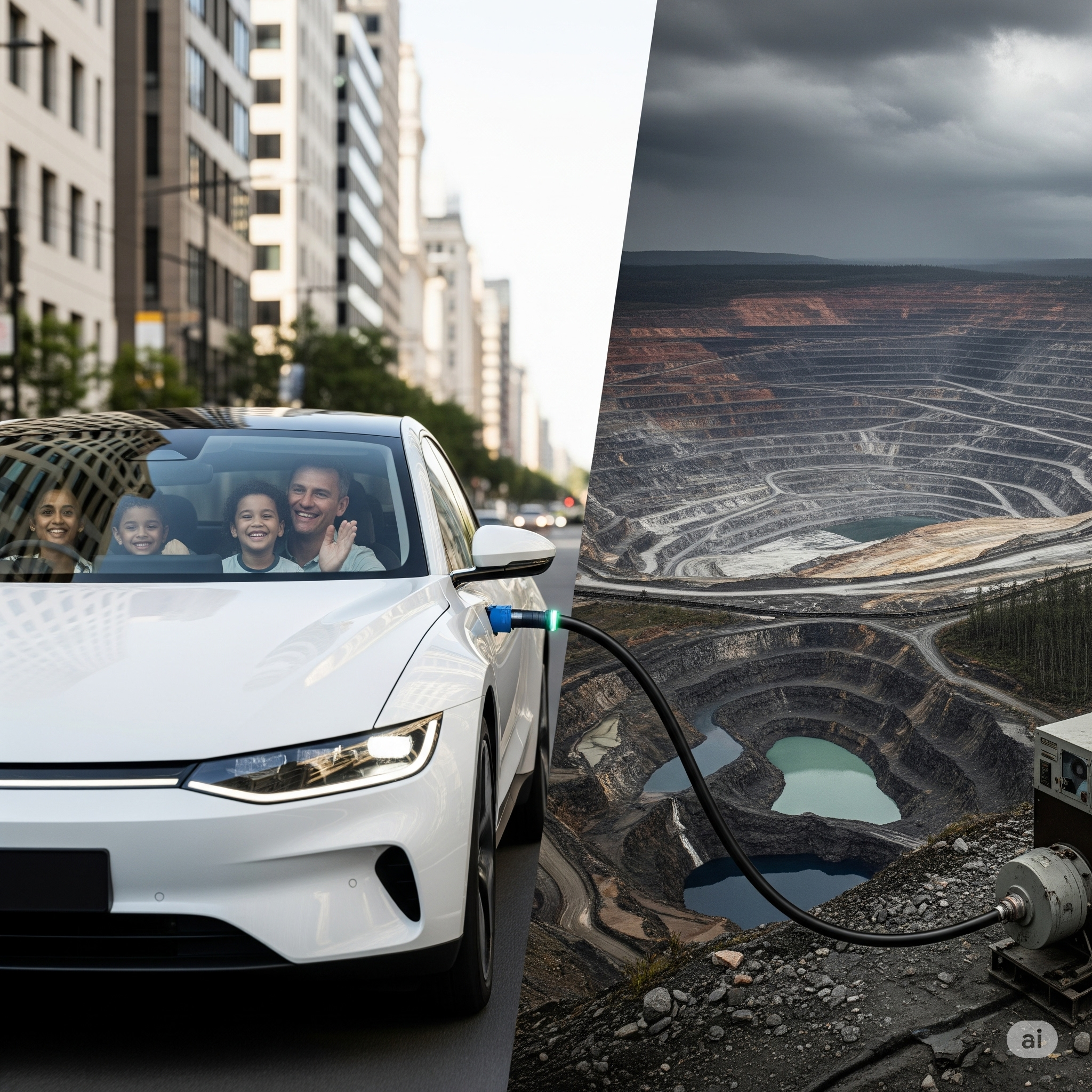Hasri Ainun
S2 HI Eskisehir Osmangazi University
“…electric vehicles are often touted as the eco-friendly solution for the low-carbon future in transportation sector. However, their supply chains are immersed in a ‘dirty’ process that contradicts with the ‘green’ future it promises. This is where the paradox of the energy transition lies: green on the surface, gray underneath…”
Current global trends are accelerating the push for a “green” and “clean” energy transition. This momentum fuels the innovation and production of environmentally friendly products, such as electric vehicles (EVs). Essentially, the global shift toward EVs is driven by urgent concerns over fossil fuel depletion, climate change, and the need to reduce greenhouse gas emissions. Commonly touted as a solution for a more environmentally friendly future, EVs are positioned at the forefront of the renewable energy transition. According to the Global EV Outlook 2024, the launch of electric vehicles is considered a major driver in reducing transportation emissions (International Energy Agency, 2024). Unsurprisingly, if compared to gasoline-powered vehicles, EVs have a smaller carbon footprint.
Therefore, the proliferation of EVs is regarded as a key action toward reducing greenhouse gas emissions, particularly in the transportation sector. Furthermore, according to the International Energy Agency, road vehicles were the most significant source of emissions among transportation subsectors, contributing more than 15% of global energy-related emissions. This emphasizes that penetrating the road transport decarbonization agenda into climate mitigation strategies is crucial. As a result, the electrification of road transportation on a global scale is expected to result in significant emission reductions in the coming decades.
The expansion of this ambitious vision has driven the EV market’s growth worldwide. Nearly one in five cars sold in 2023 was an electric vehicle (International Energy Agency, 2024). In conjunction with the increasing global demand for EVs to promote renewable energy technologies, the demand for critical minerals such as lithium, nickel, and cobalt—the primary battery components—is expected to increase. From approximately three million metric tons in 2023 to between five and six million metric tons by 2040, as stated in the Global Critical Minerals Outlook 2024. However, in 2023, just two countries produced 65% of the world’s refined nickel: Indonesia and China.
Indonesia, nickel, and the global energy shift
The global race towards decarbonization has elevated nickel from a mere metal industry to a strategic resource. Indonesia, the world’s biggest nickel deposits and producers, is expected to play a crucial role in the global energy transition, notably in the supply chain of EVs. Based on data from the U.S. Geological Survey in Mineral Commodity Summaries in January 2024, Indonesia produced 1.8 million tonnes of nickel in 2023, far beyond all other countries and even accounting for nearly half of global output. Supported by 55 million tonnes of nickel reserves, strengthening Indonesia’s dominance in a critical position to shape the future of the EV battery supply chain. Furthermore, by 2030, this country is projected to account for 44% of the world’s refined nickel.
According to the International Energy Agency, there are two main types of primary nickel products: Class 1, which is high-purity (over 99.8% nickel), and Class 2, which is lower in purity. In Indonesia, most of the nickel currently produced is classified as the Class 2 category, which is used for stainless steel manufacturing. However, there is growing pressure from the government and industry to shift to the expansion and development of Class 1 nickel processing, the primary material in battery cathodes for EVs. Indonesia strives to support the global transition to cleaner energy technologies, by developing downstream infrastructure, including new battery cell factories and partnerships with global manufacturers.
Accordingly, Indonesia is leveraging its abundant nickel reserves by positioning this mineral as a key component of its commodity-based development strategy. Several policies, such as the ban on raw commodity exports, have been adopted to encourage the development of downstream industries and attract green investments (Nickel Institute, 2024). The increasing strategic value of nickel in the global energy transition is driving Indonesia to develop an integrated EV supply chain, from mining to battery production, as part of its efforts to become a key player in the global supply chain and energy transition.
The hidden cost of green in the EV supply chain
However, behind the surface of eco-friendly branding, have you ever wondered how much it really costs to make the vision of a “cleaner” and “greener” world into reality?
The path forward in this transition progress is far more complex than it seems. Well, here lies the reality behind the EV as one cornerstone project of the global green transition. In fact, the supply chain toward green transition is even soaked in unsustainable and ecologically destructive practices. For instances, nickel as the main component of its battery, extracted from mining process that harms the environment. The way nickel is processed, and particularly how Indonesian nickel resources are transformed into material suited for EV batteries, is energy-intensive and environmentally damaging.
EVs are often touted as an environmentally friendly solution for the future. However, the raw materials used in their production and supply chain come from mining processes that damage the environment. This is where the paradox of the energy transition lies: green on the surface, gray underneath.
Behind nickel’s strategic role as a key mineral in driving the global energy transition, the nickel industry is fundamentally environmentally destructive and highly carbon-intensive due to its dependence on coal. Nickel mining in Indonesia often involves deforestation, particularly in Sulawesi and Halmahera. Given these facts, Indonesia’s central position highlights a strategic paradox. On the one hand, Indonesia supports the global green transition by supplying critical materials for EVs. On the other hand, environmental degradation caused by mining, deforestation, and industrial pollution raises ethical concerns about the sustainability of the transition itself.
This highlights the controversy behind the “green” ambition to adopt EVs, which obviously have environmental and social impacts throughout their “dirty” supply chain. It is clear that this transition is not without consequences. Based on WALHI’s research, the establishment of nickel industrial areas negatively impacts the local communities. Downstreaming practices, especially for nickel, have caused a decline in public health, loss of biodiversity, deterioration of marine ecosystems, and reduce livelihoods (WALHI, 2024). Concerns about the environmental and social impacts of nickel mining haunt the visionary aspiration for a greener and more environmentally friendly future.
In reality, the production of green technologies, such as EVs, requires massive industrial and energy inputs that are fundamentally unsustainable. Green technologies such as EVs may produce less emissions, contributing to reduced air pollution. However, their production process does not come without significant environmental and social costs. While EVs are promoted as a sustainable alternative, the upstream production of critical minerals such as nickel has significant ecological and social costs, which are—ironically—often overlooked in the global sustainability narrative.
Nickel mining reveals the underlying contradiction of the green transition, often portrayed as a global solution for a “greener,” “cleaner,” and “sustainable” future because of its significance to EVs. In a twist of irony, the product that is marketed, branded, and promoted as a symbol of a more sustainable future is born from a production process that is not entirely “clean.” Rather than promoting the principles of sustainability—where clean energy is supposed to be renewable, low-emission, and resource-efficient—it actually reproduces environmental injustice. This reality illustrates the paradox of the energy transition to renewables, creating a green facade that hides a brown reality: dirty production for clean technologies, green on the surface, gray underneath. Indeed, the destructive realities of mining are anything but green. Beneath the surface lies a trail of poisoned rivers, displaced communities, and silenced resistance.
No surprise, a narrative like EVs do not really eliminate pollution, they simply displace it—out of sight and out of mind, often to the Global South where the mining for their components takes place has emerged on the surface. The West’s aggressive ambition to pursue renewable energy on the basis of reducing emissions has essentially shifted pollution to countries with lower environmental standards. Above all, this highlights a global disparity between the Global South, the countries producing the main components for EVs, and the Global North, where EVs are primarily enjoyed. This is further evidenced by the concentration of EV sales in China, Europe, and the United States, with 95% of sales in 2023 occurring in their markets (International Energy Agency, 2024).
So, for whom is this greener and cleaner future truly intended?
Green capitalism and environmental injustice: who pays for the green transition?
Behind the rhetoric and visionary aspiration to save our planet, one must ask: who bears the cost of the global shift toward green transition?
This case illustrates the contradictions inherent in so-called “green capitalism,” where efforts to utilize renewable energy, reproduce colonial extractivism masked under the guise of sustainability, particularly in the Global South as raw material suppliers. Furthermore, the dynamic underscores the geopolitical asymmetry of the energy transition, where Western green technological demands perpetuate extractive dependencies in developing countries. Green capitalism reproduces the same patterns of exploitation, but this time under the banner of sustainability. Eventually, green capitalism is more about marketing and maintaining profits than fundamental ecological transformation. Market-based climate strategies do not address the root causes of the problem and often perpetuate environmental injustice. Once again, this becomes an extension of the capitalist class’s greediness to market the “green products” for profit by such a promising and ethical branding for the sake of the future—they claim.
Consequently, environmental technologies often shift ecological burdens onto poor countries, while developed countries claim to be undergoing a transition toward sustainability, contributing positively to the future of our planet. Behind this “clean” image lie practices that spread pollution and damage to marginalized communities in the Global South, the same old pattern that violated the environmental justice conception. In this context, green capitalism not only perpetuates inequality but also shifts costs: from the rich to the poor, from the current generation to future generations. Ultimately, the most affected groups are poor and vulnerable communities in developing countries, while global corporations and industries savor the profits. Those damages are often hidden behind eco-friendly brands like “climate-friendly cars.”
The conception of environmental degradation classified as “slow violence” by Nixon (2011) describes how this form of “violence” accumulates, occurs gradually, and is barely noticeable. This type of ‘violence’ does not “explode” but erodes the land, life, and livelihoods slowly. The costs of energy transition, such as nickel extraction for EV battery raw materials, are borne most heavily by marginalized communities, leading to cases of environmental injustice related to renewable energy projects. On this basis, resistance to environmental degradation emerges from the material struggles of poor and marginalized groups who depend on nature for survival. Or what is defined as “empty-belly environmentalism.” This emphasizes that environmentalism is neither merely romanticized by climate activists nor grounded in abstract idealism but reflects the daily struggles of local communities affected by environmental issues.
Terms like sustainable development and green transition may sound promising, ethical, and environmentally friendly with green technology emerging as a solution to global challenges. However, it is necessary to delve deeper into the lifecycle of these green technology products, critically examine their supply chains, and uncover the paradoxes behind them. An irony hid behind the normative and ecocentric visionary ideas. Claims of a clean energy transition actually end up damaging the environment, with practices that contradict their own principles within the supply chain. Green theory and political ecology reveal how sustainability discourse, when co-opted by powerful actors, encompasses the exploitation of ecosystems in the name of climate progress. Nickel mining as a form of toxic outsourcing under the banner of environmentally friendly growth. Thus, a fair and sustainable energy transition requires not only environmentally friendly outputs, but also ethically and ecologically responsible supply chains. The energy transition should not only be about replacing gasoline with batteries, but also about changing the way we think about who bears the costs of this progressive ambitions.
After all, is it really as green as you think?
References
- Astuti, R., Raman, S., & Yeremia, A. E. (2025). Putting community-centric justice into just transitions from the Global South: The case of Indonesia’s nickel sector. Environmental Research Letters, 20(5). https://doi.org/10.1088/1748-9326/adc8b9
- Berghoff, H., & Rome, A. (Eds.). (2017). Green capitalism: Business and the environment in the twentieth century. University of Pennsylvania Press.
- Busch, P., Pares, F., Chandra, M., Kendall, A., & Tal, G. (2024). Future of global electric vehicle supply chain: Exploring the impact of global trade on electric vehicle production and battery requirements. Transportation Research Record, 2678(11), 1468–1482. https://doi.org/10.1177/03611981241244797
- Castillo, R., Blumenthal, L., & Purdy, C. (2022, September 21). Indonesia’s electric vehicle batteries dream has a dirty nickel problem. Brookings Institution. https://www.brookings.edu/articles/indonesias-electric-vehicle-batteries-dream-has-a-dirty-nickel-problem/
- International Energy Agency. (2024). Global critical minerals outlook 2024. https://www.iea.org/reports/global-critical-minerals-outlook-2024
- International Energy Agency. (2024). Global EV outlook 2024: Outlook for emissions reductions. https://www.iea.org/reports/global-ev-outlook-2024/outlook-for-emissions-reductions
- International Energy Agency. (n.d.). Electric vehicles. https://www.iea.org/energy-system/transport/electric-vehicles
- Levenda, A. M., Behrsin, I., & Disano, F. (2021). Renewable energy for whom? A global systematic review of the environmental justice implications of renewable energy technologies. Energy Research & Social Science, 71, 101837. https://doi.org/10.1016/j.erss.2020.101837
- Martinez-Alier, J. (2002). The environmentalism of the poor: A study of ecological conflicts and valuation. Edward Elgar Publishing.
- Nickel Institute. (2024, July). Indonesia and its EV ambitions. https://nickelinstitute.org/en/blog/2024/july/indonesia-and-its-ev-ambitions/
- Nixon, R. (2011). Slow violence and the environmentalism of the poor. Harvard University Press. https://www.hup.harvard.edu/books/9780674049307
- Schröder, M., & Iwasaki, F. (2024). From nickel to electric cars? Indonesia’s resource cum automotive industry policy. Journal of the Asia Pacific Economy, 29(4), 2065–2086. https://doi.org/10.1080/13547860.2023.2231192
- Smith, R. (2015). Green capitalism: The god that failed. World Economics Association.
- Statista. (n.d.). Proportion of energy in global greenhouse gas emissions. https://www.statista.com/statistics/241756/proportion-of-energy-in-global-greenhouse-gas-emissions/
- U.S. Geological Survey. (2024). Nickel. In Mineral commodity summaries 2024 (pp. 116–117). https://pubs.usgs.gov/periodicals/mcs2024/mcs2024-nickel.pdf
- WALHI. (2024). Pernyataan Sikap: Tolak Investasi Nikel. https://www.walhi.or.id/uploads/blogs/Foto%20Rilis/tolak_investasi_nikel.pdf


